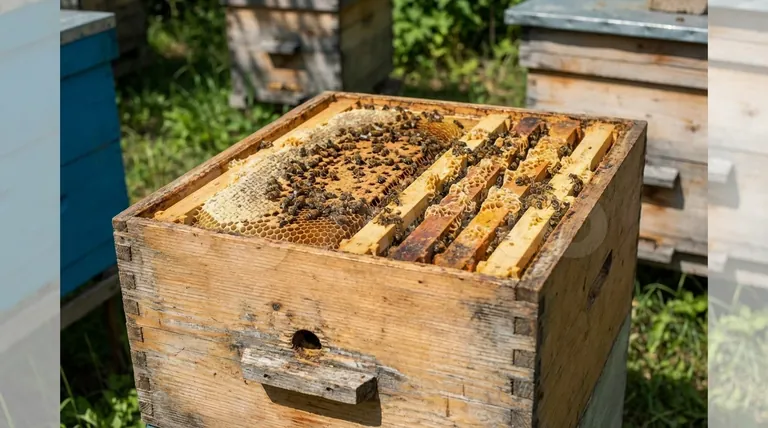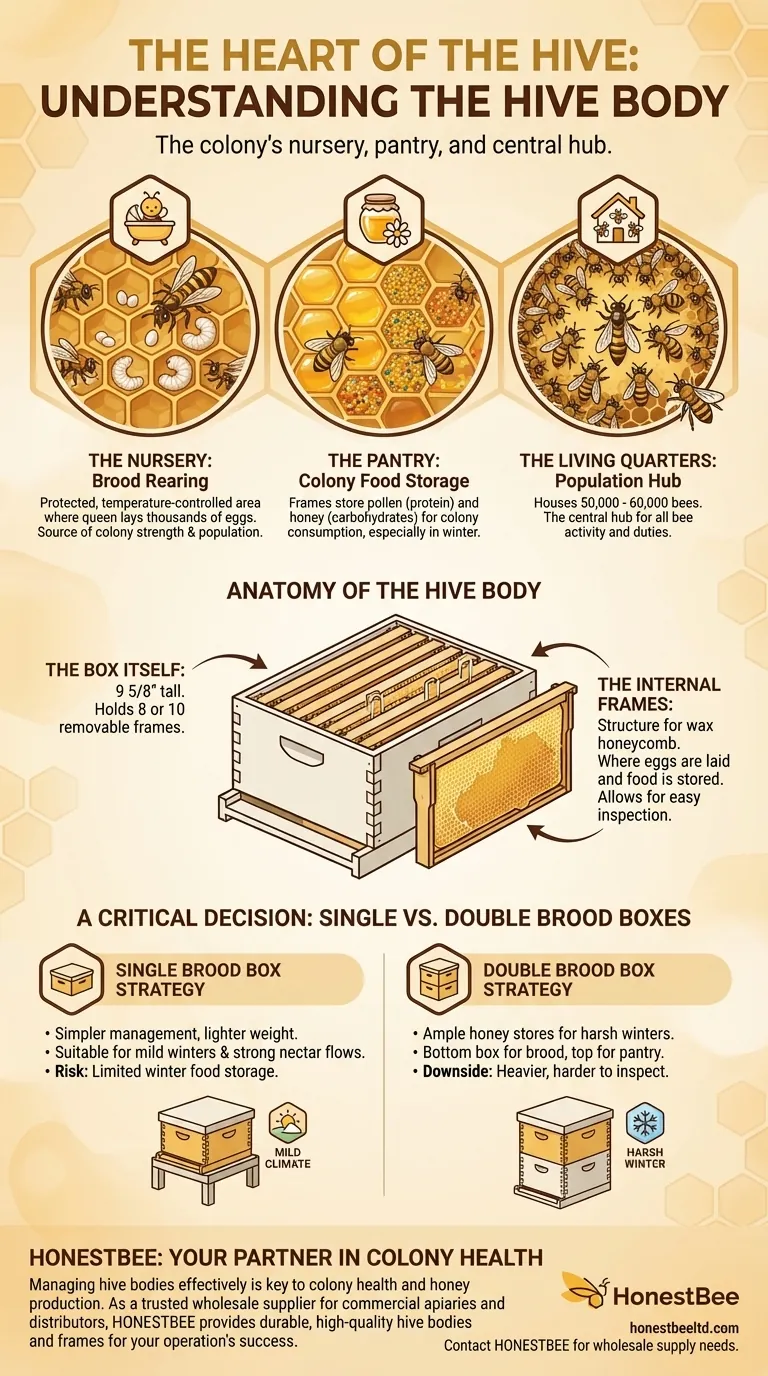In simple terms, the hive body is the heart and engine of a beehive. Also known as the brood box or brood chamber, it is the primary living quarters for the colony. This is where the queen bee lays her eggs and where the worker bees raise the young (the brood), while also storing the essential pollen and honey the colony needs to survive.
The hive body is not just a box; it is the colony's nursery, pantry, and central hub. Its proper management is the single most critical factor in ensuring the health, growth, and survival of your bees.

The Core Functions of the Hive Body
To truly understand the hive, you must understand the distinct jobs performed within the hive body. It is a multi-purpose space dedicated entirely to the well-being of the colony itself.
The Nursery: Brood Rearing
The most critical function of the hive body is to serve as the brood chamber. This is the protected, temperature-controlled area where the queen lays thousands of eggs.
Worker bees meticulously care for these eggs as they develop into larvae, pupae, and finally, new adult bees. A healthy, productive brood chamber is the source of the colony's strength and population growth.
The Pantry: Colony Food Storage
The frames within the hive body also serve as the colony's main pantry. Bees store pollen (their protein source) and honey (their carbohydrate source) directly adjacent to the brood-rearing areas.
This strategic placement ensures the nurse bees have immediate access to the food required to feed the developing larvae. The honey stored here is for the bees' own consumption, especially during winter, not for the beekeeper to harvest.
The Living Quarters: Population Hub
The hive body is designed to house the vast majority of the colony's population. A single deep hive body has enough space for 50,000 to 60,000 bees.
This space accommodates the queen, drones, and tens of thousands of worker bees performing their various duties, from nursing the young to guarding the entrance.
Anatomy of the Hive Body
The physical structure of the hive body and its internal components are precisely designed to meet the needs of the honeybee colony.
The Box Itself
The hive body is a large, rectangular box, typically measuring 9 5/8 inches tall. It is the first box placed on the hive's bottom board.
Most modern hives use a Langstroth design, where the box is built to hold either eight or ten removable frames, allowing for easy inspection by the beekeeper.
The Internal Frames
Inside the hive body hang the frames. Each frame provides the structure upon which bees build their wax honeycomb.
The comb is where the queen lays her eggs and where the bees store their food. These frames allow the beekeeper to remove and inspect the brood and food stores without destroying the comb.
A Critical Decision: One vs. Two Brood Boxes
A beekeeper's primary strategic choice regarding the hive body is whether to use a single box or to stack two, one on top of the other.
The Single Brood Box Strategy
Using a single hive body is simpler to manage and inspect. It requires less heavy lifting and can be sufficient for colonies in regions with mild winters and strong nectar flows.
However, a single box offers limited space for food storage, which can put the colony at risk of starvation during a long, cold winter.
The Double Brood Box Strategy
Using two stacked hive bodies is common practice in regions with harsh winters. The bottom box typically serves as the primary brood-rearing area, while the top box becomes a massive pantry.
This configuration provides ample honey stores to ensure the colony can survive the winter months when no nectar is available. The downside is that the hive becomes much heavier and more cumbersome to inspect.
How Hive Body Management Impacts Your Colony
Your approach to the hive body directly influences the outcome of your beekeeping efforts. Your primary goal should dictate your strategy.
- If your primary focus is colony survival through winter: Use a two-hive-body configuration to ensure the bees have more than enough honey stored to last until spring.
- If your primary focus is simplicity and ease of management in a warm climate: A single-hive-body setup can be effective and requires less heavy lifting.
- If your primary focus is rapid population growth: Ensure the queen has ample space to lay by keeping frames open and not "honey-bound," regardless of whether you use one or two boxes.
Ultimately, the hive body is the foundation of a strong colony, and its careful management is the cornerstone of successful beekeeping.
Summary Table:
| Function | Description | Key Takeaway |
|---|---|---|
| Brood Rearing | The nursery where the queen lays eggs and bees raise young. | Source of colony strength and population growth. |
| Food Storage | Stores pollen and honey for immediate colony consumption. | Critical for feeding larvae and surviving winter. |
| Living Quarters | Houses the majority of the colony's population (50,000+ bees). | The central hub for all bee activity. |
Build a stronger foundation for your apiary with HONESTBEE.
Managing your hive bodies effectively is key to colony health and honey production. As a trusted wholesale supplier for commercial apiaries and beekeeping equipment distributors, HONESTBEE provides the durable, high-quality hive bodies and frames your operation needs to succeed.
We understand the critical difference that reliable equipment makes. Let us help you equip your beekeepers for success.
Contact HONESTBEE today to discuss your wholesale supply needs and discover how our beekeeping solutions can support your business growth.
Visual Guide

Related Products
- Langstroth Honey Bee Box Hive Boxes for Different Depths
- Langstroth Bee Hives Bee Keeping Box for Beginners Beekeeping
- HONESTBEE Professional Long Handled Hive Tool with Precision Cutting Blade
- Long Langstroth Style Horizontal Top Bar Hive for Wholesale
- Multi-Functional Sliding Hive Entrance for Beekeeping
People Also Ask
- How does a hive box work? A Guide to the Langstroth Hive System for Beekeepers
- What are the sizes available for Langstroth boxes? A Guide to 8-Frame vs. 10-Frame & Depths
- How should hive boxes be aligned after reassembly? Ensure a Perfect Seal for Hive Health
- What are the sizes of supers available in a standard hive? A Guide to Deep, Medium, and Shallow Boxes
- What factors should beekeepers consider when choosing between wooden and polystyrene hives? Maximize Bee Health and Honey Production



















